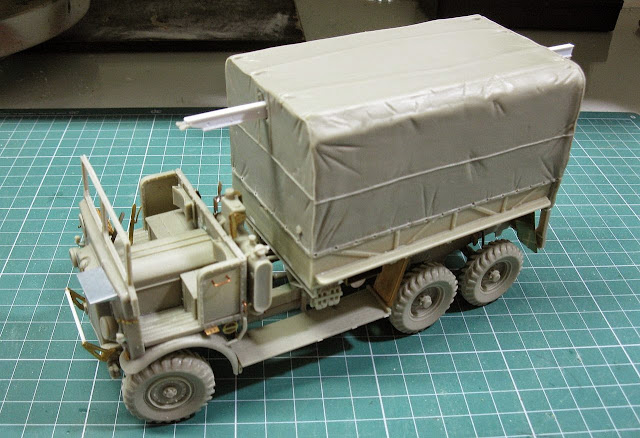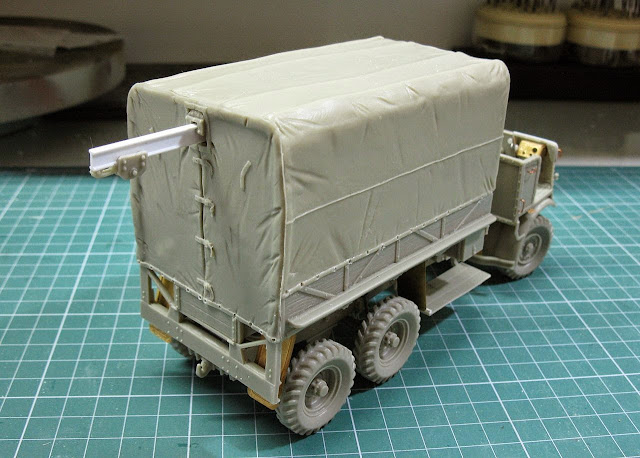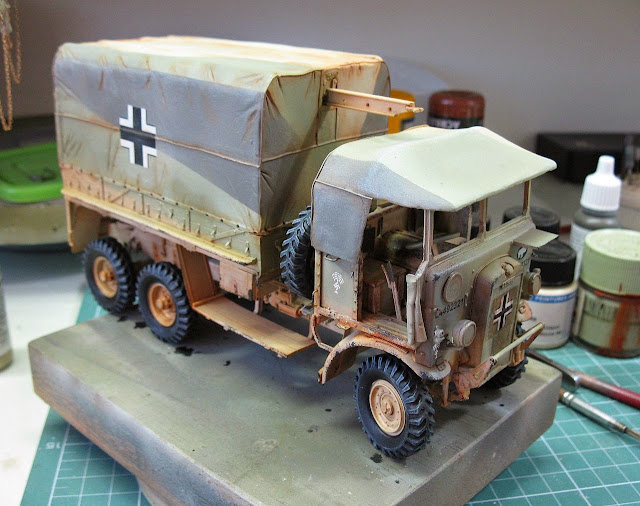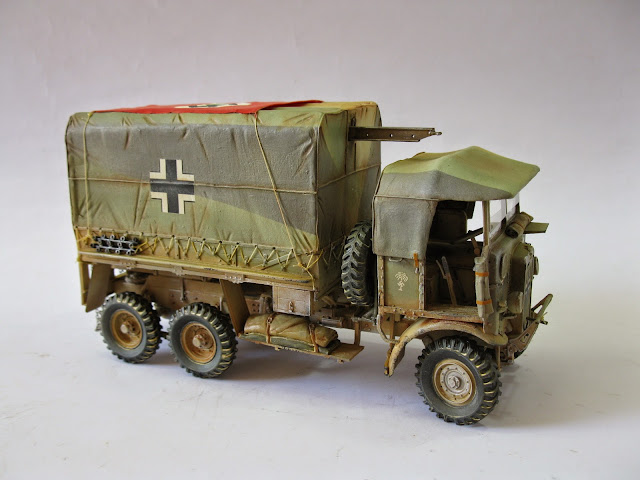Drivers !!!
Now, let's see two working girls in huge jobs: Leyland Retriver 6x4, 3 tons, in Gantry version. It will be a hard and well done job, by St. George !!!
The Leyland Retriever was a 6 x 4 truck produced by
Leyland Motors for the British Army between 1939 to 1945. These rough trucks served (very well) the British and allies throughout WWII, on all fronts, in many versions.
 |
| Leyland Retriever - gantry version - early cab |
 |
| Leyland Retriever 'Type H' cargo lorry - late |
The
General Montgomery used one Caravan as command post during WWII. This is now on display at now the Imperial War Museum Duxford
 |
| Monty's Leyland Retriever caravan in Duxford Museum. |
History of Leyland:
The company Leyland Motors was founded by
James Sumner in 1896 as the Lancashire Steam Motor Company, went on to became one of Britain’s largest manufacturers of commercial vehicles, eventually swallowing up most of the others manufacturers.
 |
| James Sumner (1860-1924) |
With the technological development of the internal combustion engines, the name was changed to Leyland Motors in 1907. Leyland supplied its first military vehicles, in the form of the X3, during the same year. During the dark years of WWI, the company supplied almost 6,000 examples of the 3-ton 4x2 S4X4 and S5X4 truck that was generally described as the ‘RAF-type Leyland’.
 |
| Leyland 4x2 3 ton RAF type 1914 |
In the late-twenties, Leyland, along with many other manufacturers, produced a 3-ton 6x4 ‘subsidy’ truck, in this case identified as the Terrier, many of which were supplied directly to the War Office. Both normal-control and forward control versions were produced under the same name. Diesel engines were first fitted in 1933.
 |
| Leyland Terrier in tests - Canadian Army - 1930's. |
By 1939, the lineage of Terrier had evolved into the 6x4 forward-control Retriever. Production continued through WWII, with some 6,500 examples. Other Leylands constructed during WWII included the 3-ton Lynx, the 6-ton Badger, which was basically a commercial vehicle, and the huge 10-ton Hippo.
 |
| Leyland Lynx 4x2 - 3 ton - 1938 |
 |
| Leyland Badger 4x2 - 6 ton - 1935 |
 |
| Leyland Hippo - 6x4 - 10 ton - 1935 |
The Leyland Hippo latter was produced in two marks: the original Mk I being little more than a pre-war commercial vehicle to which had been fitted a military open cab, whilst the Mk II, which appeared in 1944, was designed for trucking large amounts of cargo across northwest Europe following the invasion, in logistics duties.
 |
| Leyland Hippo - 6x4 - 10 ton - Open cab - 1939 |
 |
| Leyland Hippo - 6x4 - 10 ton - Closed cab - 1944 |
Leyland continued to be an important supplier of military vehicles during the decades following the WWII and the company gradually absorbed most of its rivals. However, the acquisition of British Motor Holdings proved to be a very large piece to be swallowed and, in 1975, the British Leyland Motor Corporation was nationalised. In 1987, the company was sold to
DAF, with the resulting Leyland-DAF company going into receivership in 1993. The mark Leyland now belongs to the
American Paccar Group (the famous Pacific Car and Foundry Company), since 1998.
History of 6x4 lorries:
The 6 x 4 chassis in various weight classes was first introduced in the Mid-Twenties. Sometimes referred to as the 'rigid six-wheeler, this arrangement was highly favoured by the War Office, and vehicle manufacturers were encouraged to produce these chassis by the provision of special subsidies.
They were also allowed free use of the WD-patented articulated rear bogie, which was consequently fitted to all vehicles in this class.
 |
| WD-patented articulated rear bogie in action |
By the outbreak of the War the advantages of the 4 x 4 chassis type were becoming appreciated and theoretically the 6 x 4 type was considered obsolete, but in practice a number of problems in the development of the newer type resulted in 6 x 4's remaining in production throughout the WWII.
This particularly applied where specialist bodies were concerned, as it was found that the 4 x 4's were not capable of carring the types of body that had hitherto been fitted on the longer 6-wheel chassis. This explains why the majority of six-wheelers in service during the War were used for bulky loads such as Pontoon carrying, Bridging, Derrick, Gantry, etc. The chassis built for General Service use were mainly fitted with a well-type wooden body of standard pattern, the major exception being the Austin K6 which was fitted with a metal body.
 |
| Austin K6 - 6x4 - Crane |
The number of types in this class was more-or-less evenly split into normal-control and forward-control chassis. The latter types were all introduced pre-War, and all had the standard WD-pattern open cab with canvas folding hood and sidescreens. To say the least, these must have been rather uncomfortable machines to drive: some vehicles, particularly some Leyland Retrievers, did have a full windscreen, but this was by no means a common fitting. Of the normal-control types, the Austin K3/YF was the only one to have an open cab, although retaining its civilian style front end, but this was replaced in the early years of the War by the Austin K6 with a closed cab. This cab was the same as the K3 3-ton 4 x 2 chassis, but the radiator grille was a simpler, flat-fronted affair, and flatter section mudguards were fitted, making the appearance quite distinctive.
 |
| Austin K3 4x2 lorry |
The majority of K6's were supplied to the R.A.F., and the Army only used the chassis for three purposes: GS, Breakdown Gantry and Coles Crane mounting.
 |
| Austin K-6 - 6x4 lorry - Gantry version |
All the forward-control types with open cabs were very similar in appearance. The easiest identification area is of course the radiator grille, but as radiator muffs were often a standard fitting, it is sometimes extremely difficult to work out what manufacture a vehicle in a photograph actually is. Subtler identification points have to be resorted to, such as the shape of the front mudguards or the wheel pattern for example. There were in fact no less than seven manufacturers producing this type of vehicle: Guy, AEC, Albion, Leyland, Thornycroft, Crossley and Karrier. Apart from the Austin K6, the other normal-control types were the Dodge
COE WK-60 and Fordson WOT1 and E917T series, and once again the majority of these were supplied to the R.A.F.
 |
| Dodge COE WK-606x4 - Gantry version |
 |
| Fordson WOT 1 - 6x4 - RAF Barrage Balloon Winch |
 |
| Fordson E917T - 6x4 - RAF Barrage Balloon Winch |
The E917T was a militarised version of the pre-War commercial Fordson 'Sussex' chassis, having American-style cab and front end, and was replaced by the WOT1 series. This was the largest of Fordson's War Office Transport standardised range, and used the same cab, bonnet and other components as on smaller vehicles in the range. The transmission system on the WOT1 was rather unusual in that the leading drive axle had two crown wheels and two pinions, one for driving the back axle, instead of the worm drive more common in vehicles of this type.
History of Leyland Retrievers:
The first models had an open cabin with canvas top. Later versions were a windscreen and metal doors. The Retriever was a three-axle vehicle with two rear drive axles (6 × 4).
 |
| Leyland Retriever 6x4 - 3 ton (early) - open cab. |
 |
| Leyland Retriever 6x4 - 3 ton (late) - closed cab. |
On behalf of the British War Office developed rear axle was prescribed by the UK MoD for the Retriever and all other trucks built for the British Army with three tons of payload, so also for Crossley Motors IGL8, Guy Motors FBAX, Thornycroft Tartar and Karrier CK6.
 |
| Crossley Motors IGL8 - 6x4 lorry |
 |
| Guy Motors FBAX - 6x4 lorry |
 |
| Thornycroft Tartar 6x4 lorry |
 |
| Karrier CK6 - 6x4 lorry |
The Leyland Retriever had a standard structure with a front cab and then the cargo section. The first ones had an open cab with only a canvas roof. The driver was not protected by a windscreen or metal doors, but later versions got this one. The four-cylinder Leyland petrol engine had a displacement of 5,895 cc and was water cooled. The engine had a power of 73 hp.
 |
A Leyland Retriever engine under restoration
Notice the four pistons
font:http://hmvf.co.uk/ |
 |
Leyland Retriever engine under restoration
font:http://www.mapleleafup.net |
The gearbox had four speeds and there was two reduction gear provided to ensure that driving in high and low gearing was possible. The cargo of the Retriever could be covered with a canvas roof. The fuel tank had a capacity of 141 liters. The spare tire was mounted between the cab and the loading area.
The vehicle had only drive on the four rear wheels (6x4). The rear axle was a draft of the British War Office and the Ministry had this available to all truck manufacturers which produce for the British army. Similar vehicles with a three-tonne payload and 6x4 drive, the Crossley IGL8, Guy FBAX, Thornycroft Tartar and Karrier CK6. These were all produced in the same time.
Besides the standard truck version, there were special versions for the entrainment of pontoons and bridging, mobile workshops, as a platform for searchlights, gantry and cranes. The crane was usually a Coles MkVI type gasoline-electric drive. A separate petrol engine drove a generator on. The lifting capacity was about 3 tons.
 |
| Leyland Retriever equipped for the bridging role. |
 |
| Leyland Retriever equipped as mobile workshop |
 |
| Leyland Retriever equipped with gantry |
 |
| Leyland Retriever in desert |
 |
| Leyland Retriever Gantry in desert. Notice the baloon tyres |
 |
Leyland Retriever Gantry in German hands
doing german jobs...Notice the caunter cammo... |
 |
| Another Leyland Retriever Gantry in the desert... |
 |
| Leyland Retriever Gantry - rear view |
 |
| Leyland Retriever equipped with Coles MkVI crane |
There was also an armored version, the
Leyland Beaver-Eel, with various armaments, like 20mm gun, 7.7 MGs, which was used for the defense of military airfields in England. Around 336 units of this armed version were produced.
 |
| Leyland Retriever type C Armored Tender "Beaver-Eel" |
 |
Leyland Retriever type C Armored Tender "Beaver-Eel" with skirts
Notice the RAF markings |
Between 1939 and 1945 a total (standard and specialized versions) of 6542 Leyland Retrievers lorries were produced.
Specs:
| Leyland Retriever 6x4 3 ton. |
|---|
| Type | 6x4 wheel drive, general purpose truck |
|---|
| Country of origin | England |
|---|
| Development history |
|---|
| Manufacturer | Leyland Motors |
|---|
| Production period | 1939 - 1945 |
|---|
| Number | 6.542 vehicles |
|---|
| Specifications |
|---|
| Length | 6.85 m |
|---|
| Width | 2.27 m |
|---|
| Height | 3.45 m |
|---|
|
Engine
Transmission
Tyres | Leyland - 5.895cc
4-cylinder petrol engine
73hp @ 2100 rpm
4 speed + 2 gear (red.)
9.00 x 20 |
|---|
| Cargo capacity | 3t (60 CWT ) |
|---|
| Fuel capacity | 140 L |
|---|
| Range | 312 km |
|---|
The kits:
For this project, I'll use the awesome Resicast LEYLAND RETRIEVER GANTRY TRUCK "CLOSED TILT" (#351232). This will be a double project, because I will build two girls: one for me and another in commission for my good friend Alois. Go ahead, Tommy !!!
Indeed, these British lorries are awesome, by Jove!! Congrats to
Resicast: amazing models !!!
Well, Gentlemen ... My friend Alois requested that his truck was an English vehicle captured by the Germans ...Something like this:
Deutsches Afrikakorps
 |
Leyland Retriever Gantry
Notice the caunter scheme cammo and the german crosses... |
It was very common for Germans, when captured a vehicle to use, simply marked the machine with their own markings, usually in large sizes and keeping the markings of their former owners.
But, first of all, let's take a look at the Caunter Scheme:
The colors;
...and the painting job:
The decals are from my spare parts box,
Archer decals and decals made by myself, with my lasercolor...
 |
Notice the extra-large german crosses in the sides of the lorry
DAK palm tree in the sides (Bison decals) |
The decal in the radiator grill was a disaster...Microsol, Microset, Future...Nothing works...The silvering always showed his awful face...
 |
Crap !!! Awful decal in the radiator. I'll get it out !!!
British markings: the proud rhino from 1st Armoured Division
and DAK markings (in white) |
After trying everything to get the decal in decent way, I ripped out the cross and painted the marking using brush 00 and steady hand ....
 |
Painted by hand and swet...Much better...
starting the weathering... |
 |
Selecting stuff in the sides of lorry. Value Gear
is always a good choice... |
 |
| Panzerserra's decals... |
 |
| Mickey Mouse cammo scheme |
 |
| Notice the glossy aspect; Future |
Starting the final details. Installing the ropes of canvas...Polyester thread:
 |
| drilling the holes and gluing the threads with cyanoacrylate |
 |
| First, the threads of the holes... |
 |
´...then, passing the ropes by the hooks and gluing
the ropes in the base of the canvas. Voiláá |
 |
| European ok. African starts... |
 |
| Ropes in place... |
 |
| Close-up. Notice the Value Gear stuff in place... |
My friend Alois would like the captured truck sported a reconnaissance flag to avoid being destroyed by the Luftwaffe. I found this historical example:
 |
Opel bus with nazi flag in the roof.
Prevention against friend airstrike... |
Well, I have in my scrap-box one decal from RPM with Nazi flag. I'l use the white circle and the swastka only. The flag will be made with tracing paper brushed with PVA glue.
 |
| Starting the nazi flag... |
I painted the tracing paper with red and white with Vallejo. After the painting dries, I put Future in the white circle (brush) and applied the decal with swastika. This is the result:
DISCLAIMER
"The publication of any images or informations related to nazism, fascism or any other totalitarian regimes must be understood as the reproduction of historical accuracy and not as apology to these regimes, leaders or symbols."
 |
| Final results |
 |
And the nazi flag in the captured lorry.
Messerschmitts and Stukas: I'm friend !!! |
The lorries finally were done. First, the Leyland Retriever Gantry 6x4 originally belonging to the
1st Armoured Division and after his capture, providing services to
Deutsches Afrikakorps (DAK), North Africa, 1942.
 |
| Leyland Retriever Gantry 6x4 - Afrikakorps - left side |
 |
| Leyland Retriever Gantry 6x4 - Afrikakorps - right side |
 |
Leyland Retriever Gantry 6x4 - Afrikakorps - with
Kojak and Rover, the dog. |
 |
Leyland Retriever Gantry 6x4 - Afrikakorps and Sherman I for size comparison.
Two girls in the desert ... |
 |
Leyland Retriever Gantry 6x4 - 79th Armoured Division
1st Assault Brigade Workshop (Special) - REME, France, 1944. |
 |
| Leyland Retriever Gantry 6x4 - 79th Armoured Division - left side |
 |
Leyland Retriever Gantry 6x4 - 79th Armoured Division - with
Kojak and Rover, the dog. |
 |
| The two Leyland Retrievers Gantry 6x4 |
 |
| three girls in size comparison. |
In conclusion, the kits of
Resicast are very, very good. Fine castings, few defects and easy adjustments to be solved ...Resin kits are more complex than plastic, but nothing that a little attention and care in order to get excellent results.
Thanks for following ...























































































































































